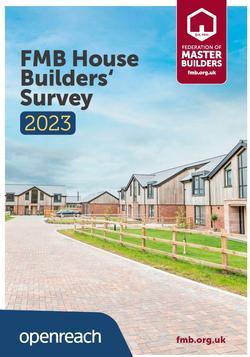
The FMB House Builders' Survey, which has now been running for over a decade, provides a comprehensive breakdown of the major barriers stopping small, local house builders from delivering homes.
It also explores a wide array of broader factors that influence the market for small, local house builders.
Key findings
Main constraints on supply
- The planning system is rated as the top major barrier holding back the delivery of new homes at 55%.
- Restricted mortgage availability becomes the second largest barrier with 51% of members picking this option, which is a steep rise over the last two years.
- Lack of available land, a new category, separating it from viability of land, is the third biggest barrier at 48%.
- Material costs are the fourth biggest barrier with 43% of members choosing this option, but members indicated this will fall to 23% over the next three years.
- The fifth most significant barrier holding back housing delivery is the lack of finance to the company at 42%.
Buyer demand
- Buyer demand is at its lowest level since 2015 (when the survey began recording this data), with an average score of 1.99 (rated out of 5, with 5 being very good and 0 being very poor).
Planning application process
- Respondents once again rated ‘Inadequate resourcing of planning departments’ as the most significant cause of delay in the planning application process, followed by ‘Inadequate communication by planning officers.’
- Cost imposed by delays in the [planning] system is the most significant cause of additional cost in the planning process.
- 45% of members have medium certainty in the planning process, with 32% seeing a low degree, and 11% a very low degree. When combined only 12% had a high or very high degree of certainty in the outcome of a planning application.
Small sites and land availability
- 63% of respondents report that the number of small site opportunities is decreasing, down from 82% last year, with 5% reporting that the number is increasing.
- 60% have reported that the process of obtaining planning for small sites seems to be getting worse.
- 59% of members do not believe that the NPPF requirements on local authorities to identify small sites is helping.
Workforce and skills
- 24% of respondents are planning to grow their on-site workforce over the next year.
- 12% are planning to decrease their on-site workforce.
- 57% will be keeping their workforce at roughly the same size.
- 50% of respondents said they would be upskilling their workforce.
- There was a slight increase in those that reported to be hiring one or more apprentices with 36% in 2023 compared to 40% last year.
Access to finance
- When asked to rate lending conditions to micro, small and medium-sized (MSMEs) for residential development from 0 to 5 (0 being very poor and 5 being very good), the average score was 1.84 – which is the lowest figure since 2017.
- ‘Interest rates charged on new loans’ was again rated as the most significant finance related issue restricting the ability to build new homes.
- Self-build/custom contracts are the most popular source of funding for a project (53%).
- 94% of members have indicated it’s become more expensive to build over the last year.
- Of the 94% noted above that said it had become more expensive to build, 53% said it was around 20% more expensive, with 1 in 5 noting it was 30% more expensive per site.
Future of housebuilding
- 68% of members are aware of the Future Homes Standard.
- 55% have indicated that they think there will be increased costs owing to the Future Homes Standard.
- The majority of respondents indicated they are not at all confident about Biodiversity Net Gain (BNG) which comes into force next year (71%).
- 30% of FMB house builders want to understand who to talk to about BNG.




